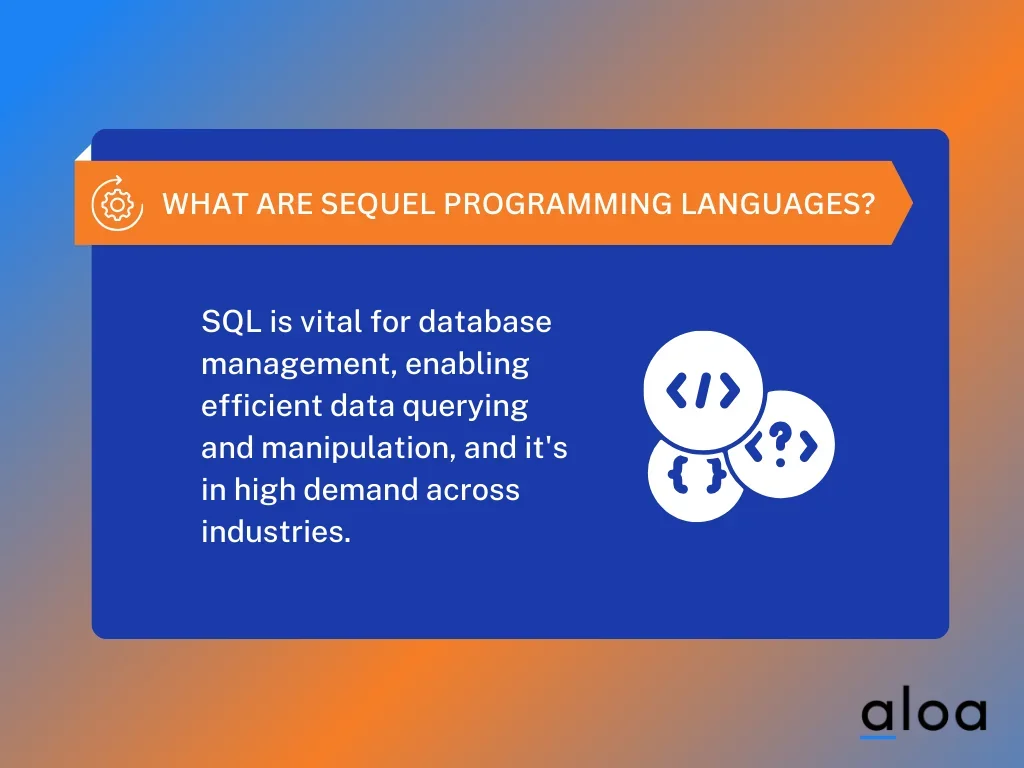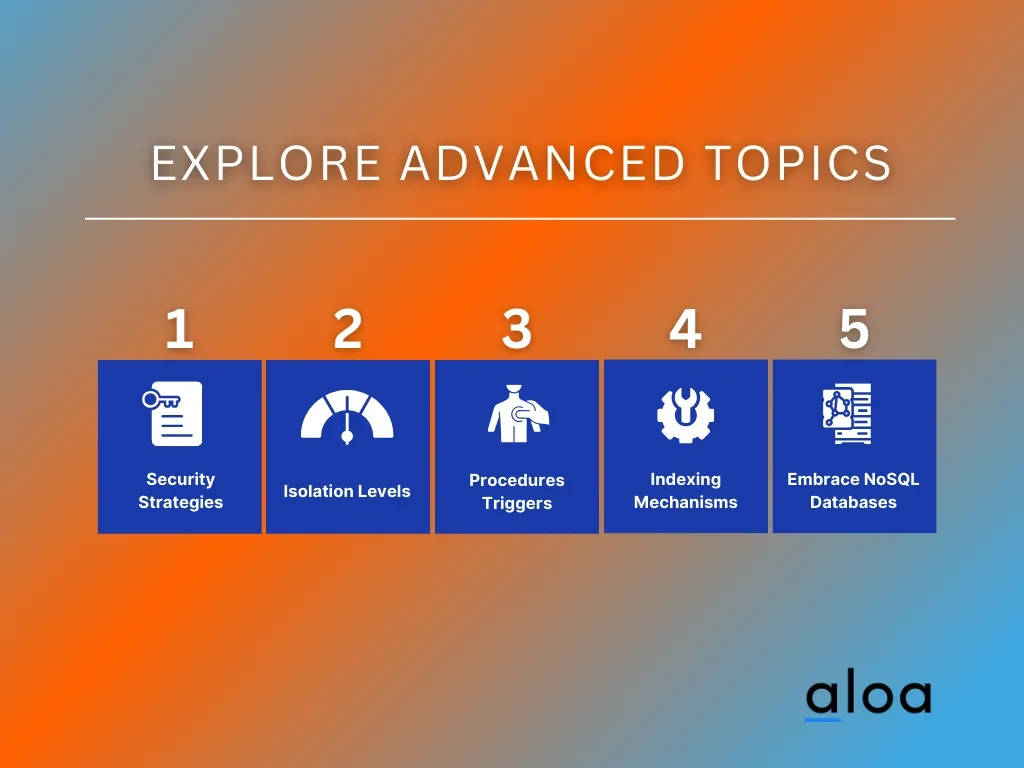A Guide to SQL Programming Languages for Developers
The demand for more efficient and adaptable programming languages intensifies as technology advances. Structured query language, in particular, are becoming increasingly relevant in today's dynamic business landscape, aligning seamlessly with the evolving needs of software development teams and organizations.
At Aloa, we recognize the critical role of structured query language in modern software development. Leveraging our expertise and industry insights, we aim to provide comprehensive guidance on the challenges of programming languages. With Aloa's commitment to delivering valuable insights, startups can make informed decisions on programming languages and maximize the potential of these innovative tools.
Based on our expertise in database management for building software solutions, we’ve curated this blog to uncover SQL’s essential features, practical applications, and best practices for implementation. We will share with you the resources needed to use structured query language efficiently and drive your software development initiatives forward.
Let's dive in!
What are SQL Programming Languages?

Structured query language, also known as SQL, are crucial for database management in 2024. SQL is the standard language for relational database systems like MySQL and Oracle, which enables efficient data manipulation. Its syntax focuses on managing data and interacting with databases effectively, making it indispensable for modern applications.
SQL (structured query language) stands apart from conventional programming languages such as JavaScript or JAVA. Explicitly designed for data exchange and database manipulation, SQL employs unique syntax for defining variables, loops, and patterns within databases. While SQL databases may vary in deployment extensions, it remains universally recognized for its capability in manipulating data across diverse software environments; teams that learn sql can apply the same skills across multiple RDBMSs.
Mastering SQL empowers developers to query and manipulate data efficiently and enables them to optimize database performance while ensuring data integrity. From creating tables and defining relationships to querying complex datasets, proficiency in SQL continues to rise, making it a valuable skill set for aspiring and seasoned developers.
How to Use SQL Programming Languages
Using structured query language is crucial for anyone in database management. It is primarily used to interact with relational database systems such as MySQL, Oracle, and SQL Server, and it also facilitates seamless data transfers, like from SQL Server to Redshift. Mastering SQL enables users to efficiently perform essential database operations like data insertion, deletion, modification, and retrieval.
Below are five easy steps on how to use SQL programming languages.

Step 1: Understand the Basics
Before embarking on the journey of mastering programming languages, developers must first understand its foundational concepts. This entails familiarizing oneself with structured query language (SQL) and its pivotal role in database management.
Here are some factors to consider when mastering the language:
- Understand Relational Database Management Systems: Facilitates proficient SQL programming by delving into the architecture and functionality of RDMS.
- Explore Data Types in SQL: Allows developers to handle different data types effectively.
- Master the Relational Model of Data: Empowers developers to design and optimize databases for enhanced performance and scalability.
Step 2: Set Up a Database
Kickstarting your journey with structured query language demands thoughtful consideration of your database choices. Let's discover how to set this database up.

- Choose the Appropriate Database: Select the database that best suits your project's requirements, considering scalability, performance, and data integrity.
- Install a Relational Database Management System: Install and configure a robust RDBMS like MySQL or PostgreSQL to serve as the foundation for your database operations.
- Ensure Compatibility: Verify that your chosen RDBMS is compatible with your programming language to facilitate seamless integration and interaction.
- Design Your Database Structure: Craft a well-thought-out database structure tailored to your project needs, defining relationships and data types for optimal organization and efficiency.
- Execute SQL Commands: Utilize SQL commands to create tables and populate them with initial data, laying the groundwork for your database operations.
Step 3: Learn SQL Syntax
Learning the curves of structured query language hinges on understanding its syntax, the cornerstone of database management. Key considerations to consider include:
- Understanding SQL Statements: Gain insight into SQL statements that manipulate and retrieve data from databases, forming the backbone of database interaction.
- Familiarizing with Basic Commands: Acquaint yourself with essential commands like SELECT, INSERT, UPDATE, and DELETE, laying the groundwork for database manipulation.
- Filtering WHERE Clauses: Refine your expertise in filtering WHERE clauses, empowering precise data retrieval based on specified conditions.
- Sorting with ORDER BY: Explore the functionality of ORDER BY to sort query results in ascending or descending order, enhancing data presentation and analysis.
- Diving into JOINs: Delve into JOIN operations to combine data from multiple tables, facilitating comprehensive data analysis and reporting.
Step 4: Practice Writing Queries
To effectively master a structured query language, practicing writing queries is essential. Developers can enhance their understanding of SQL syntax, data manipulation techniques, and database management by engaging in hands-on query creation. This practice hones individuals' skills in crafting efficient and accurate queries while familiarizing them with various SQL commands and best practices.
Take a closer look at these factors to enhance your proficiency in writing queries:
- Refine Query Skills: Develop the ability to construct SQL queries that retrieve, insert, update, and delete data from databases, enabling the crafting of precise and efficient queries to manipulate data effectively.
- Optimize Performance: Experimenting with different query structures and joining techniques enhances query performance, boosting application efficiency by improving performance and optimizing database operations.
- Consider Debugging Practices: Gain proficiency in swiftly identifying and rectifying errors, enhancing critical thinking and debugging abilities.
- Real-World Application: Gain exposure to diverse datasets and scenarios, preparing to address real-world challenges through practical experience.
Step 5: Explore Advanced Topics
Ready to explore deeper into SQL programming? Advanced topics like SQL optimization, database security, and performance tuning await, enhancing your skills and expanding your expertise in database management. Other advanced topics that you can practice on include:

- Database Security Strategies: Strengthen your understanding of security protocols and strategies to safeguard sensitive data from potential threats and breaches.
- Transaction Isolation Levels: Dive deep into transaction isolation levels to ensure data integrity and consistency in multi-user database environments, enhancing reliability and scalability.
- Stored Procedures and Triggers: Learn to implement stored procedures and triggers to automate routine tasks and enforce data integrity constraints, optimizing database management processes.
- Indexing Mechanisms: Explore indexing mechanisms to improve query performance and accelerate data retrieval by efficiently organizing and accessing database records.
- Embrace NoSQL Databases: Expand your database management skills by embracing NoSQL databases. This lets you gain insights into alternative data storage solutions and the evolving landscape of data management technologies.
Features of a SQL Programming Language
SQL programming languages are foundational for managing and analyzing data in various digital environments. With their intuitive syntax and robust querying capabilities, these languages enable custom software developers to interact seamlessly with databases and derive valuable insights from complex datasets.
From small-scale data manipulation tasks to large-scale database management operations, structured query language provide the flexibility and power required to meet the evolving needs of modern data-driven applications. Let's explore the features of such a language below.

Declarative Syntax
One of the defining characteristics of structured query language is their declarative syntax. This syntax enables developers to articulate what they want from the database without specifying how to achieve it, akin to the structured English query language (SEQUEL), SQL's predecessor.
Using common English keywords, SQL enhances query comprehension and simplifies query composition. Emphasizing logic over implementation details streamlines query development, with the RDBMS optimizing for efficiency. This enhances code readability and maintainability.
Data Manipulation Abilities
Structured query language empower developers with robust data manipulation capabilities essential for various database operations. These include writing SQL queries to retrieve specific data, updating existing records, inserting new data, and deleting entries as needed.
SQL's versatility allows developers to filter, sort, aggregate, and perform calculations on data, leveraging a range of data types for adequate storage and manipulation. Ultimately, SQL programming languages streamline complex data operations, facilitating efficient retrieval and manipulation of database information.
Transaction Management
Transaction management, a vital aspect of structured query language, ensures the integrity and reliability of databases. SQL languages enable developers to execute sequences of SQL statements as single work units, guaranteeing successful execution or rollback in case of errors. Developers control transactions through commands like COMMIT and ROLLBACK, maintaining consistency and reliability amidst concurrent transactions and system failures.
Advanced SQL server features like savepoints and nested transactions empower developers to manage complex scenarios, ensuring data integrity across multiple databases. Transaction management plays a crucial role in SQL programming, upholding the accuracy and dependability of data in database systems.
Data Abstraction and Modularity
Data abstraction and modularity are fundamental features of structured query language, enabling effective organization and management of database structures. Data abstraction simplifies complex data structures, facilitating representation through tables, views, and indexes in languages like SQL. This helps developers focus on the data's logical structure, making it easier to design, maintain, and query databases efficiently.
Meanwhile, modularity enhances code reusability and scalability by breaking down systems into independent modules, supported by stored procedures, functions, and triggers. It simplifies managing and updating each component without affecting the entire system, promoting collaboration among development teams. This concurrent work on different modules accelerates development cycles and boosts project efficiency.
Compatibility and Integration
Structured query language offer compatibility and integration capabilities that allow developers to use SQL in various software applications. SQL is compatible with different languages, making it easy to integrate its queries with applications written in Java, C#, Python, and PHP. This allows developers to build high-performing data processing applications that interact seamlessly with major SQL database systems.
SQL is also compatible with web applications, allowing developers to build dynamic and interactive websites that retrieve and display data from a database. To create robust and scalable web applications, SQL can be used with web development frameworks, such as Django or Ruby on Rails. This integration enables developers to exchange data between different systems.
Benefits of Using SQL Programming Languages
Structured query language streamline data operations with standardized practices for efficiency, while robust security measures prioritize data integrity. Since they are accessible and scalable, they accommodate developers of all skill levels.
Consider these benefits of using SQL programming languages:

Ease of Use
A key benefit of using structured query language is their ease of use. SQL uses common English keywords in its statements, making it relatively easy for developers to learn and understand. The declarative syntax of SQL allows developers to focus on the logic of their queries rather than the implementation details.
As a result, it enhances the readability and maintainability of the code. SQL also provides a user-friendly interface for interacting with the database, allowing developers to write complex queries and perform data manipulations efficiently.
Portability
With portability as a critical feature, developers can write SQL code that effortlessly migrates between different database systems. SQL follows standards defined by organizations such as ANSI and ISO, ensuring compatibility across various database systems.
This portability allows developers to write SQL code that can be used in various applications and environments without significant modifications. Developers can write SQL code for one database system and easily migrate it to another without substantial changes, saving time and effort in the development process.
Efficiency
Structured query language offer efficient database performance. SQL allows developers to write optimized queries that can retrieve data from the database quickly and efficiently. Developers can use SQL query optimization techniques, such as indexing and query execution plans, to improve the performance of their applications.
SQL also provides features for database optimization, such as data normalization and denormalization, to ensure efficient data storage and retrieval. Using SQL, developers can build applications that handle large datasets and complex queries while maintaining high performance and responsiveness.
Scalability
Developers leverage the scalability of structured query language to create applications capable of managing vast datasets and adapting to expanding user needs. SQL databases can scale vertically by increasing the server's computing resources, such as CPU and RAM, to handle larger workloads.
This scalability is crucial for web development, where applications must handle many concurrent user requests and process large datasets. SQL databases provide the tools and features, such as clustering and replication, to ensure high availability and scalability in web development.
Data Integrity
Data integrity is vital to structured query language. SQL provides mechanisms for ensuring data integrity in a relational database management system (RDBMS). With that, developers can define and check constraints, such as primary and foreign keys, to enforce data integrity rules in the database. These constraints prevent the insertion of invalid or inconsistent data into the database.
SQL also provides transaction management capabilities, such as the COMMIT and ROLLBACK commands, to ensure the database's atomicity, consistency, isolation, and durability (ACID) properties. Using SQL's data integrity features, developers can build reliable and robust applications that maintain the integrity and accuracy of the data stored in the database.
Key Takeaway
Structured query language are pivotal in advancing software development and meeting the evolving demands of modern businesses. SQL languages' diverse features and robust frameworks empower developers to create sophisticated applications. Whether enhancing existing systems or building new solutions, its versatility provides the foundation for innovation and growth in web development.
In today's competitive environment, agility and efficiency are paramount, making SQL programming languages indispensable tools for businesses striving to maintain a competitive edge. Employing these languages enables organizations to streamline development workflows, expedite time-to-market, and focus on delivering exceptional user experiences.
Stay informed of the latest industry trends and developments by visiting Aloa. Explore our curated selection of blogs and articles on SQL language development tailored to your objectives. For additional support or expertise, contact our skilled web developers, who can help bring your vision to fruition!

